Tropical Heritage Garden Diary:
August 2013:
1 August:
Young Durian with hat!
2 August:
Crinkly and Straight Squash plants
Turmeric Small and Large
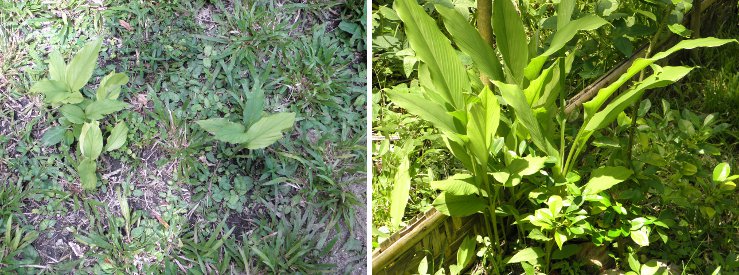
A small pile of Beans

Mung Mung, Cowpea and Bush Sitaw Bush
Large Sorghum and Happy Caterpillar
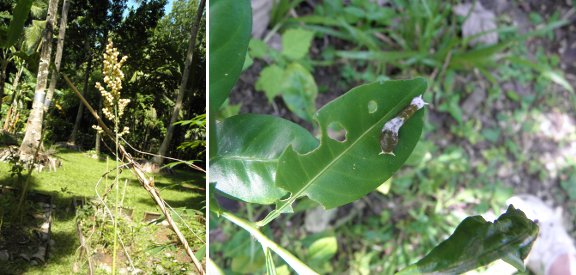
3 August:
A Nice Bunch of Bananas
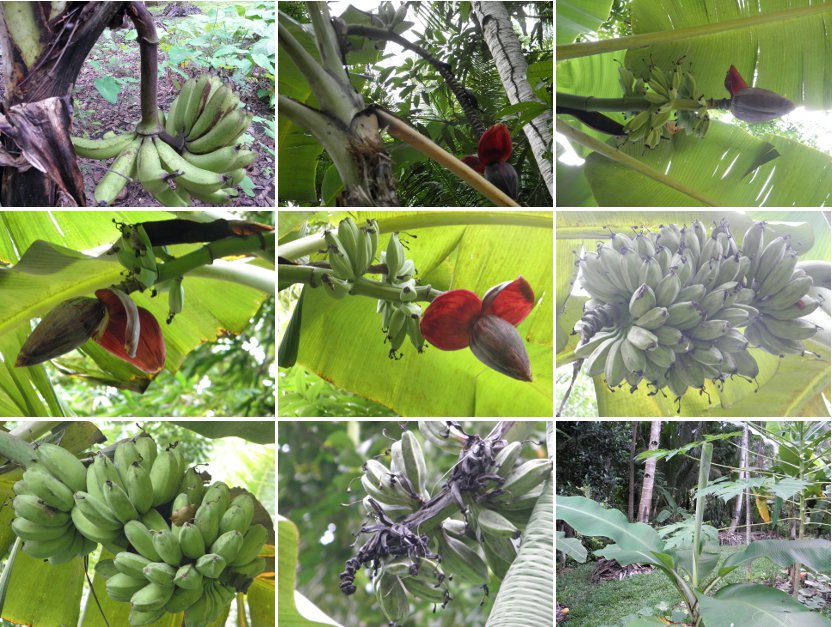
Fatima has been reading
a book on fermentation (The
Art of Fermentation by Sandor Katz). One of the
subjects covered is the collection and preparation of seeds,
So I decided to experiment with the latest batch of seeds
from a market bought Squash.
Basically, the seeds were allowed to ferment naturally (wild fermentation) by putting pulp and seeds in water and leaving the natural micro-organisms in the air to do their work. After a few days, the seeds are washed, sieved to remove the pulp -and then dried for saving.
Basically, the seeds were allowed to ferment naturally (wild fermentation) by putting pulp and seeds in water and leaving the natural micro-organisms in the air to do their work. After a few days, the seeds are washed, sieved to remove the pulp -and then dried for saving.
Preparing Squash Seeds
Ferment
Wash
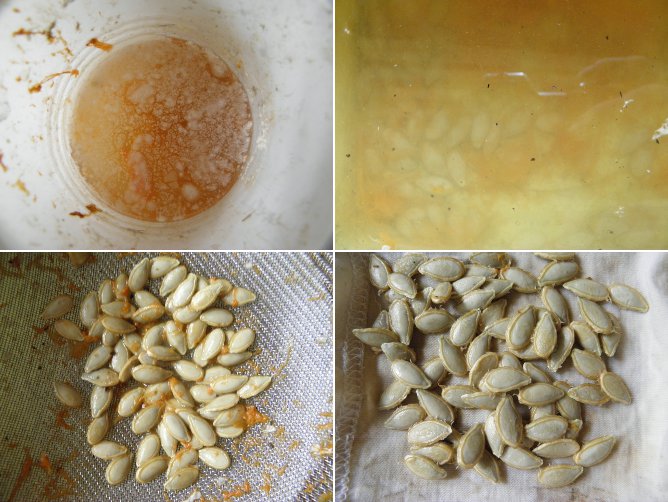
Sieve
Dry
5 August:
Ants Attacking Caterpillars Attacking Beans
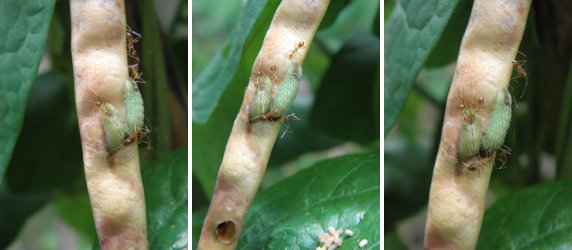
6 August:
It's been raining a lot during
the last few days (and nights).
During a pause in the rain, started cleaning up another
vegetable patch (V.1B).
7 August:
Worked (in the afternoon) on cleaning up V.1B -but rain stopped
play.
There was also flooding along the South-Westen edge, by the Ginger patch (V.2E). Perhaps caused by the neighbour (who is building a house there) dumping lots of soft rock around his house and covering most of his garden. The amount of runoff from his garden presumably depends on how porous the dumped material is. Luckily, it does seem fairly porous. In any case, our garden now seems to drain quite quickly. I'm encouraging grass and weeds in all the area where the earth is still bare. Maybe some more Cassava, Camote Tops or Kangkong to encourage better drainage via their root systems.
There was also flooding along the South-Westen edge, by the Ginger patch (V.2E). Perhaps caused by the neighbour (who is building a house there) dumping lots of soft rock around his house and covering most of his garden. The amount of runoff from his garden presumably depends on how porous the dumped material is. Luckily, it does seem fairly porous. In any case, our garden now seems to drain quite quickly. I'm encouraging grass and weeds in all the area where the earth is still bare. Maybe some more Cassava, Camote Tops or Kangkong to encourage better drainage via their root systems.
8 August:
Lots of rain today -but I finally
finished renovating V.1B.
It is now ready for further planting.
It seems that the local Pineapple can have seeds. A neighbour gave us one and while eating it we found several. Despite the rain, I managed to plant some in two pots -one with just normal soil, and in the other some composting vegetable remains, because it occurred to me that the seeds might grow better if allowed to ferment naturally in some of the Pineapple pulp. Unfortunately, this had already been eaten by us, or given to the pig, so composting vegetable remains were the best we had. Maybe we'll do better next time.
The new patch was covered with chopped coir, which will be left for a few days to rot down a bit. However, some 2nd generation Cowpea were planted in the new patch, also to help improve the soil.
Patola, Upo, Ampalya and Cucumber were planted in various parts of the garden where they have a chance to climb.
It seems that the local Pineapple can have seeds. A neighbour gave us one and while eating it we found several. Despite the rain, I managed to plant some in two pots -one with just normal soil, and in the other some composting vegetable remains, because it occurred to me that the seeds might grow better if allowed to ferment naturally in some of the Pineapple pulp. Unfortunately, this had already been eaten by us, or given to the pig, so composting vegetable remains were the best we had. Maybe we'll do better next time.
The new patch was covered with chopped coir, which will be left for a few days to rot down a bit. However, some 2nd generation Cowpea were planted in the new patch, also to help improve the soil.
Patola, Upo, Ampalya and Cucumber were planted in various parts of the garden where they have a chance to climb.
Before and After renovation
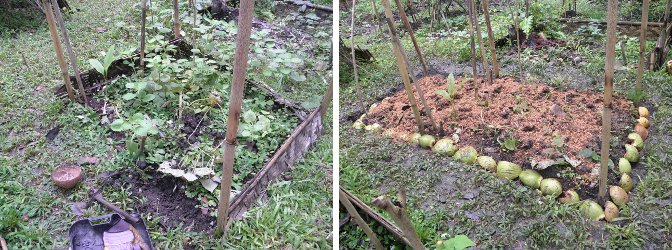
Eaten, Eating, Harvested and Growing

9 August:
2nd generation Burmese Okra planted in the
new patch (see photo above of
V.1B) after
soaking in water for 24 hours.
A neighbour gave us from her garden some long red flowers with seeds on -which were planted in various (flower) patches around the front of the house (including the new areas under the Lanzones).
It is also Fatima's birthday -so we went out to lunch. While out, we bought some "Air-Plants", a mini Bromeliad, and a few other potted decorative plants. When we got home, the seeds we had ordered had also arrived.
A neighbour gave us from her garden some long red flowers with seeds on -which were planted in various (flower) patches around the front of the house (including the new areas under the Lanzones).
It is also Fatima's birthday -so we went out to lunch. While out, we bought some "Air-Plants", a mini Bromeliad, and a few other potted decorative plants. When we got home, the seeds we had ordered had also arrived.
Birthday Plants
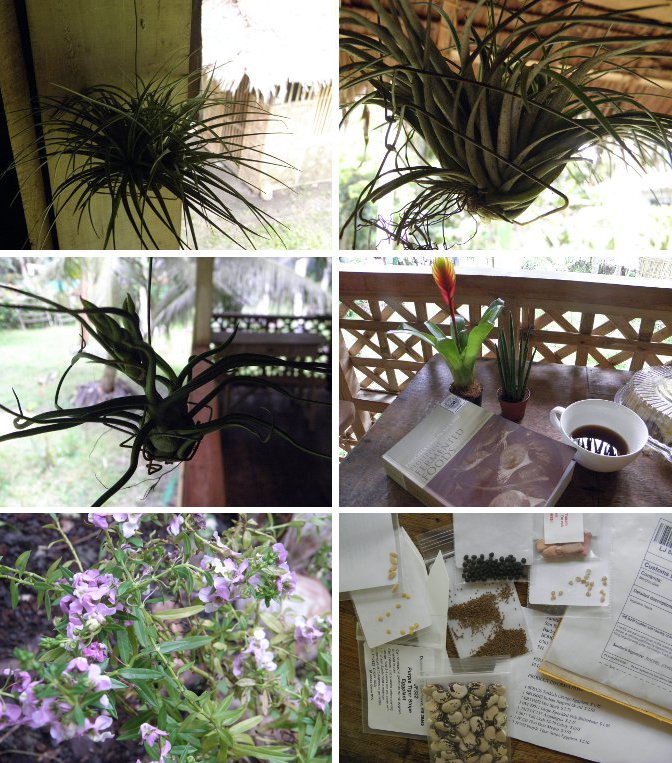
10 August:
Planted Today:
In the new patch: 2nd generation Mung and Bush Beans were planted first. Then Mesclun Salad and Dragon Stir Fry Mix were broadcast separately in labeled areas. Blue Bonnet and Penny Rice were also planted separately in labeled areas. Finally, a mixture of assorted Sweet Peppers, Cauliflower, Kangkong, Chinkang, Pechay, Red and White Onion, Red and White Radish, Carrot, Tomato, Eggplant, Shisho, Sweet Marjoram, Caraway, Korean Hyssop and Edible Chrysanthemum were broadcast over the patch.
Macupuno Corn was also planted in the above patch and various other patches (mostly among growing Bean plants).
In the new patch: 2nd generation Mung and Bush Beans were planted first. Then Mesclun Salad and Dragon Stir Fry Mix were broadcast separately in labeled areas. Blue Bonnet and Penny Rice were also planted separately in labeled areas. Finally, a mixture of assorted Sweet Peppers, Cauliflower, Kangkong, Chinkang, Pechay, Red and White Onion, Red and White Radish, Carrot, Tomato, Eggplant, Shisho, Sweet Marjoram, Caraway, Korean Hyssop and Edible Chrysanthemum were broadcast over the patch.
Macupuno Corn was also planted in the above patch and various other patches (mostly among growing Bean plants).
Fenugreek
was put in water to soak for 24 hours -ready for planting
tomorrow.
11 August:
Planted the Fenugreek in various
labelled locations.
Used trunk from recently
harvested Banana tree
plus fallen Coconut branches
to improve area under second Dwarf
Coconut tree.
Another Improvement
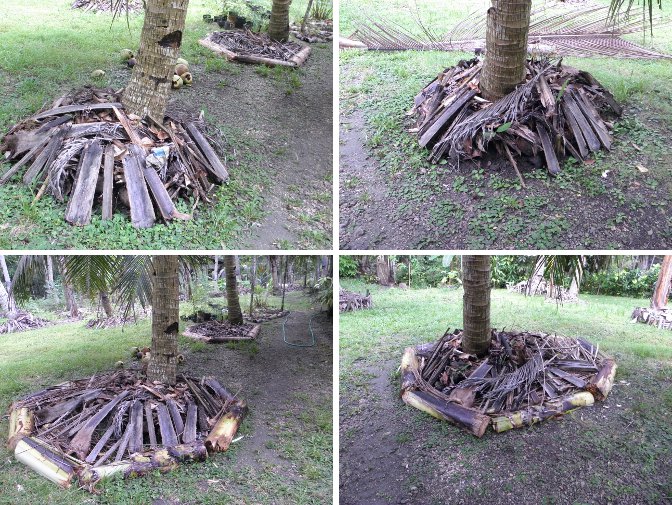
12 August:
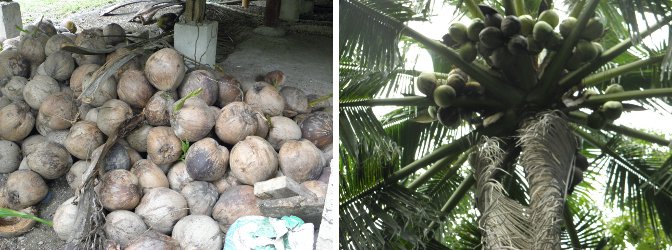
Windfall under the house -and still on the tree
13 August:
At the "Sandugan"
(26 july) we bought
250 grams of
worms. Penny and Fatima
are looking after them. Already we have been able to harvest
both worm casts and
a few eggs.
Apparently, adult worms
do not adapt well to changes of diet caused by being placed
in a new environment. So, by distributing worm eggs around the
garden in various locations, we hope the newly hatched worms
will adapt better to conditions in the garden. It is my view
that worms (like other things)
should be free and active improving the environment -rather
than being farmed for profit, and being used in labour
intensive and probably inefficient ways to cover up the poor
management of natural resources.
However, for the time being, they are, hopefully, a useful source of soil improving organisms.
However, for the time being, they are, hopefully, a useful source of soil improving organisms.
Vermiculture
Worms
Casts
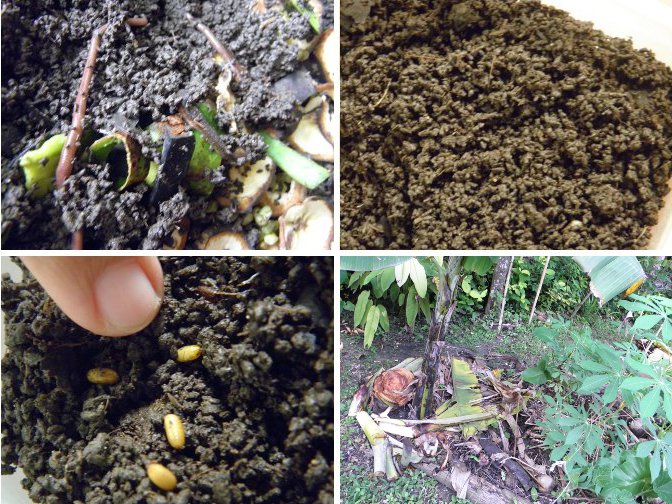
Worm
Eggs
New Home
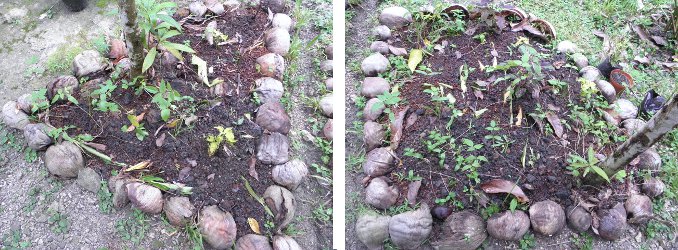
(Established 22 July)
New and Old mini-gardens under Coconut trees
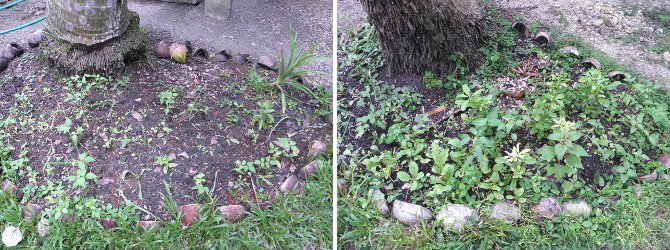
(see 24 July) (see 12 June)
Both Sides of a newly renovated plot
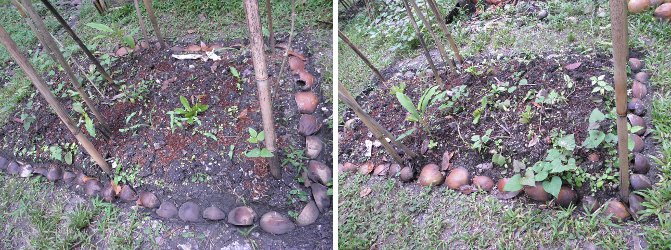
(V.1B see 8 August)
The sun is also noticeably shifting to the Northern garden -which is becoming more sunny.
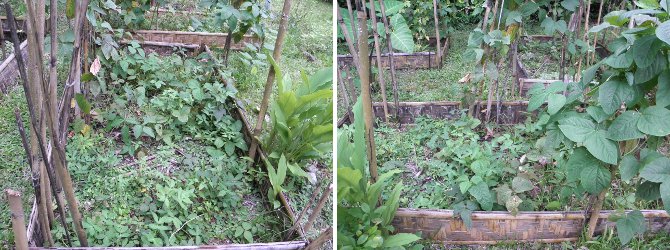
(N.1B)
Perhaps this is why, for some (perhaps intuitive) reason, despite a general tendency towards "no weeding" -I decided to clean up the Banana patch in the Northern garden -which has been fairly neglected for some time now. While cleaning up, I noticed that the process (or perhaps the result) influenced my decisions on what to plant there. Certainly the loss of weeds from the Banana patch represented an increase in compost for the nearest Coconut tree.
Clearly, the weeds had improved the soil in the Banana patch, however, it was still a little "thin" -so, instead of merely broadcasting seeds mixed with soil, as I usually do with mass seed plantings -I covered the grains with soil mixed with chopped coir -and then added another thin layer of chopped coir over the entire patch. The Okra and Maize were buried just below the surface -which is my usual practice with large seeds.
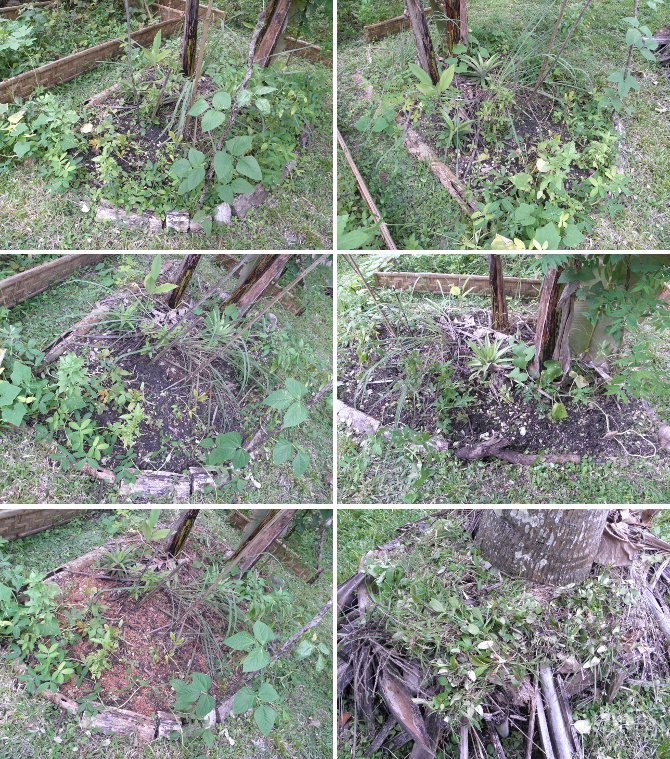
24 August:
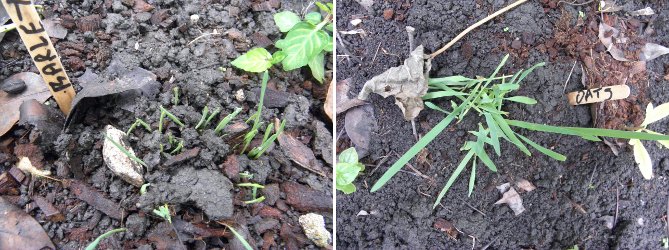
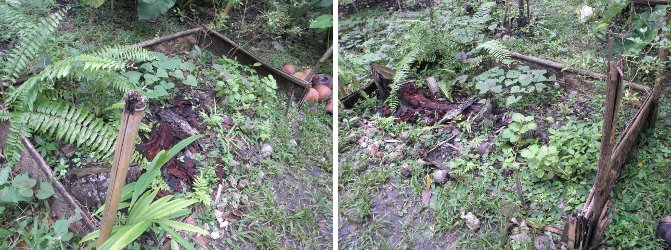
(V.1C)
25 August:
28 August:
29 August:
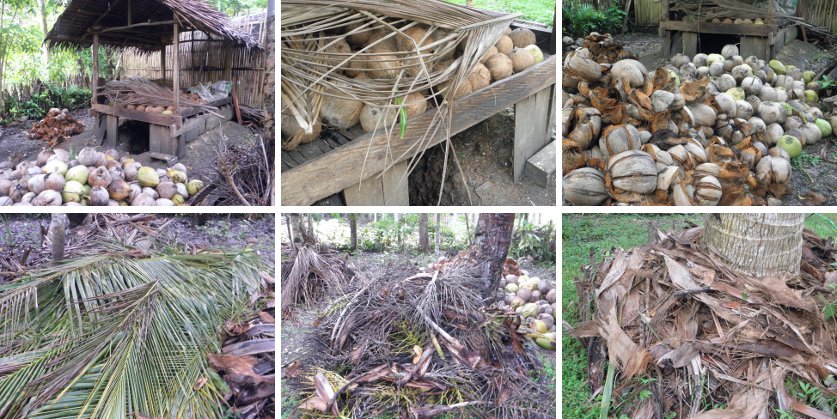
Trimmed Branches Dead Flower Stems Matting from the Trunk
Planted Today:
Chinkang (Green Bucks),
2nd. generation Mung
Beans and
2nd. generation Bush
Sitaw in H.3.
Lemon Grass, 2nd. generation Burmese Okra, 2nd. generation Bush Sitaw, supermarket Sweet Pepper and a few fermented market Squash planted along the South West hedge, near the original Durian tree.
Afternoon rain stopped any further work.
Lemon Grass, 2nd. generation Burmese Okra, 2nd. generation Bush Sitaw, supermarket Sweet Pepper and a few fermented market Squash planted along the South West hedge, near the original Durian tree.
Afternoon rain stopped any further work.
14 August:
When we went into town on
Monday,
we discovered that the animal foodstuffs shop was selling Wheat, Barley, Oats and
Sunflower seeds
separately. So we bought 250 grams of each. Today (before it started raining
in the afternoon) I distributed some in various
(labeled and unlabeled)
places around the garden. Some were planted separately
in the soil and others just mixed up and thrown down
onto the "compost"
areas under Coconut
and Banana
trees.
17 August:
Fatima's sister sent
us a whole load of seeds: Balsam Pear, Two types of Pumpkin (round and pear-shaped),
decorative Bottle Gourd, Angled
Loofah, Cucumber, Cherry Tomato, Eggplant (round and long), Sweet Pepper and Red Radish.
19 August:
As part of
tidying-up, planted, in various locations,
the few loose seeds we were still drying (Bush
beans, Hot Pepper, Cow Peas, Baguio Beans).
20 August:
Planted
Today:
Balsam Pear (V.4E),
Penny Beans, Long
String Beans (Chinese), Loofah (angled and round),
Upo and
Ampalya amongst the climbing frames.
Cherry Tomato (T.4A and various other locations).
Cucumber (mostly in the Northern Garden) and assorted Squash (including fermented)in various locations, mostly under trees.
Cherry Tomato (T.4A and various other locations).
Cucumber (mostly in the Northern Garden) and assorted Squash (including fermented)in various locations, mostly under trees.
Some Oats have
sprouted -some Barley
too -but it was wiped out already by the chickens, so
have replanted some.
The Wheat and Sunflower have remained dormant (or been eaten).
The Wheat and Sunflower have remained dormant (or been eaten).
The pile of Coconuts under the
house is still growing. We shall have to harvest soon.
It has been quite windy recently (Typhoon in the North)
and the falling Coconuts
can be quite dangerous. I got hit a glancing blow in
the back today. Luckily, with no apparent damage.
Hopefully, Penny and
Terri will do the Copra this weekend -although the price
of Copra is
so low that we all will not earn much money from it.
21 August: Planted
Today:
Macapuno White Maize
soaked for a few hours and planted in various
(Southern)
locations.
Eggplant (round, long and Chinese) planted in labelled pots. A mixture was planted in a fourth pot -and covered with a plastic bag.
Asparagus in N.1A -and together with Artichoke and Cardoon in N.2B and 2nd Banana patch.
Last of the (2nd Generation) Mung Beans distributed under the Snake Bean Climbing frame.
A few (2nd Generation) large Sorghum seeds planted in various locations.
Eggplant (round, long and Chinese) planted in labelled pots. A mixture was planted in a fourth pot -and covered with a plastic bag.
Asparagus in N.1A -and together with Artichoke and Cardoon in N.2B and 2nd Banana patch.
Last of the (2nd Generation) Mung Beans distributed under the Snake Bean Climbing frame.
A few (2nd Generation) large Sorghum seeds planted in various locations.
Assorted Okra put in soak
for planting tomorrow.
Watered much of both Northern and Southern Gardens. The wind dries the garden very quickly. Sometimes one goes from flooding to cracked earth in just a few days. Although some patches seem to dry out quicker than others.
22 August:Watered much of both Northern and Southern Gardens. The wind dries the garden very quickly. Sometimes one goes from flooding to cracked earth in just a few days. Although some patches seem to dry out quicker than others.
Developing mini-garden
under Lanzones Trees

(Established 22 July)
Until now, I have been fairly "Seed" orientated -i.e.
I take some seeds that I would like to plant -and then
look foir a place to plant them.
However, now I notice that I'm becoming more "Place" orientated -i.e. when i see a certain patch, I think of planting certain seeds there, or doing something to it.
However, now I notice that I'm becoming more "Place" orientated -i.e. when i see a certain patch, I think of planting certain seeds there, or doing something to it.
New and Old mini-gardens under Coconut trees

(see 24 July) (see 12 June)
Both Sides of a newly renovated plot

(V.1B see 8 August)
The sun is also noticeably shifting to the Northern garden -which is becoming more sunny.
Full of Beans -and other
things......

(N.1B)
Perhaps this is why, for some (perhaps intuitive) reason, despite a general tendency towards "no weeding" -I decided to clean up the Banana patch in the Northern garden -which has been fairly neglected for some time now. While cleaning up, I noticed that the process (or perhaps the result) influenced my decisions on what to plant there. Certainly the loss of weeds from the Banana patch represented an increase in compost for the nearest Coconut tree.
Clearly, the weeds had improved the soil in the Banana patch, however, it was still a little "thin" -so, instead of merely broadcasting seeds mixed with soil, as I usually do with mass seed plantings -I covered the grains with soil mixed with chopped coir -and then added another thin layer of chopped coir over the entire patch. The Okra and Maize were buried just below the surface -which is my usual practice with large seeds.
Tidying up the Banana
patch

Planted
Today:
In the new
Coconut mini-garden: Amaranth, Edible
Crysanthemum, Lions tail, Korean Hyssop, Sweet
marjoram, Purple Shisho and Caraway.
In the Banana patch: assorted Okra, Macapuno White Maize, Oats, Barley, Wheat and Sunflower.
In N.1B and N.2D: assorted Okra and Macapuno White Maize.
In the Banana patch: assorted Okra, Macapuno White Maize, Oats, Barley, Wheat and Sunflower.
In N.1B and N.2D: assorted Okra and Macapuno White Maize.
Watered the planted
areas after planting.
A single Long Bean (Sitaw) was harvested from N.1C -but more Beans (of various sorts) are on the way!
A single Long Bean (Sitaw) was harvested from N.1C -but more Beans (of various sorts) are on the way!
24 August:
Grains Sprouting

(V.4A)
(V.3E)
Ready for Renovation

(V.1C)
Rain stopped play -no
more renovation work today!
25 August:
Raining almost all day
today too.
28 August:
Have been busy the last
few days and so unable to work in the garden. Today,
the garden seemed very dry. However, it started
raining before I could finish watering!
Several of the Squash plants are doing well (although not yet producing fruit). Some are still recovering from the damage received on Monday, during the coconut harvest -which had become necessary because of the danger from falling coconuts in the wind and the rain.
Several of the Squash plants are doing well (although not yet producing fruit). Some are still recovering from the damage received on Monday, during the coconut harvest -which had become necessary because of the danger from falling coconuts in the wind and the rain.
29 August:
Coconuts -Copra and
Compost
Waiting for processing
Ready to be split for
drying
Husked and unhusked

Trimmed Branches Dead Flower Stems Matting from the Trunk
First
the Coconuts
need to be removed from their outer husks (Coir -which
earlier was used for making rope and now is chopped for
compost). Then they are split open and the
inside "meat" is dried and removed from the
shell. The resulting dried Copra is chopped up
and sold. The coconut water can be drunk as well as
used for other products. We shall be making vinegar
from it.
We also make our own cooking oil (using about 10 Coconuts a week) but this is made by cooking fresh Coconut milk (grated coconut mixed with water and squeezed out)and not from dried Copra. In warmer weather it is possible to ,produce oil by fermentation instead of cooking.
We also make our own cooking oil (using about 10 Coconuts a week) but this is made by cooking fresh Coconut milk (grated coconut mixed with water and squeezed out)and not from dried Copra. In warmer weather it is possible to ,produce oil by fermentation instead of cooking.